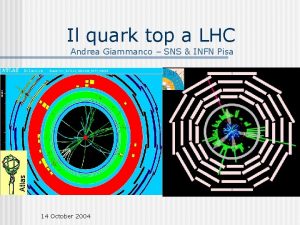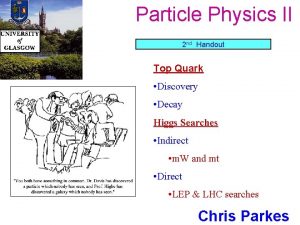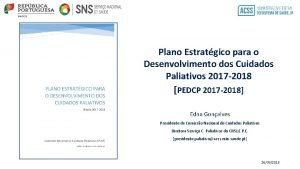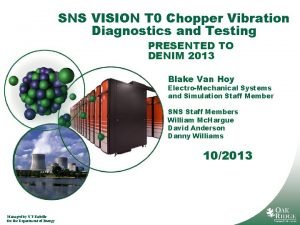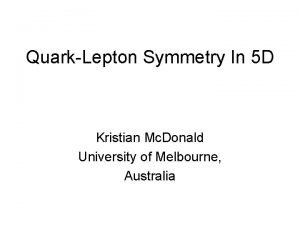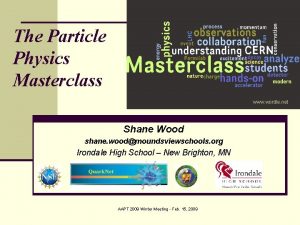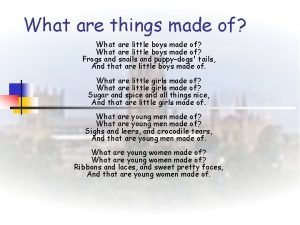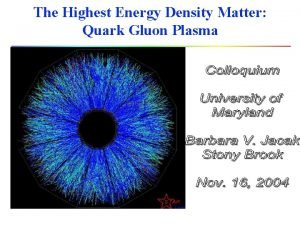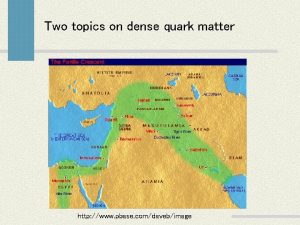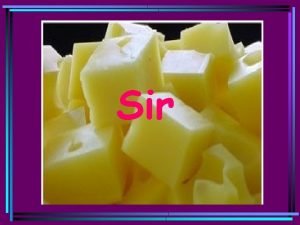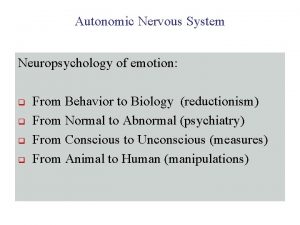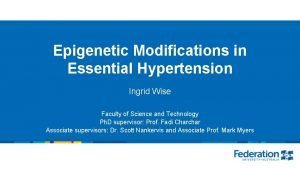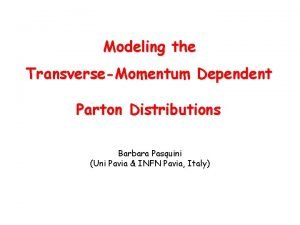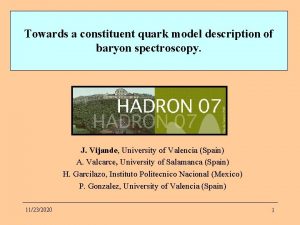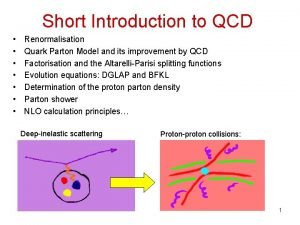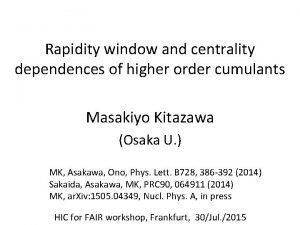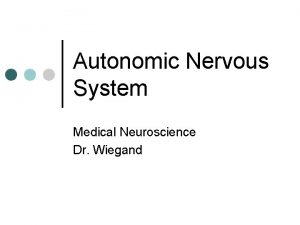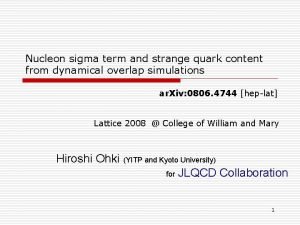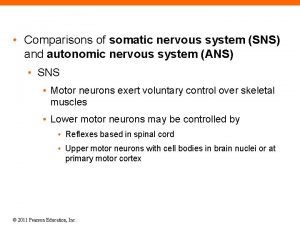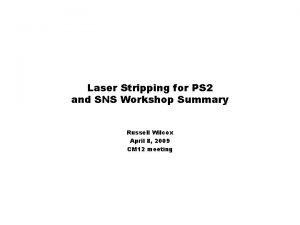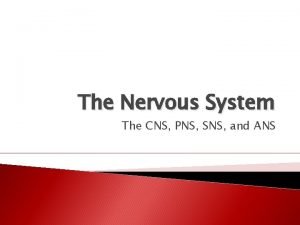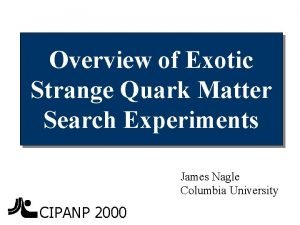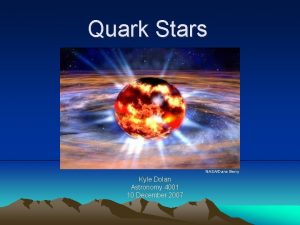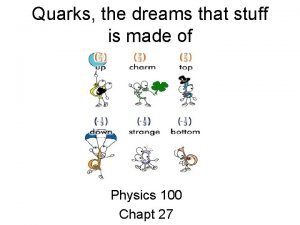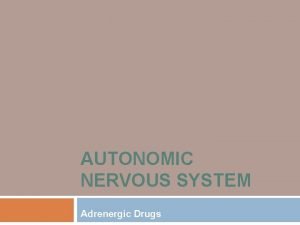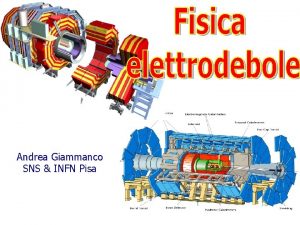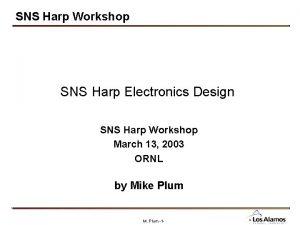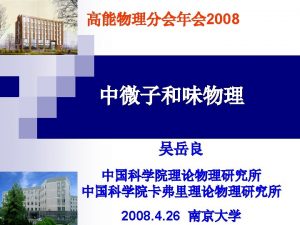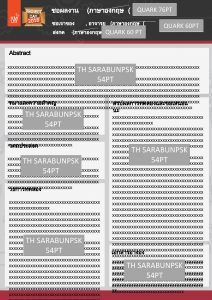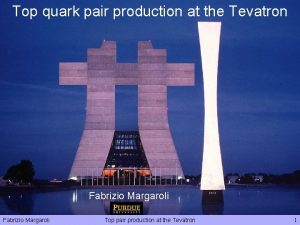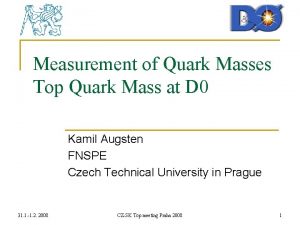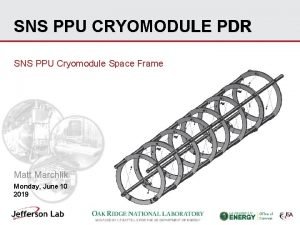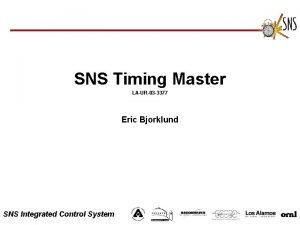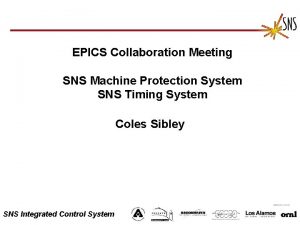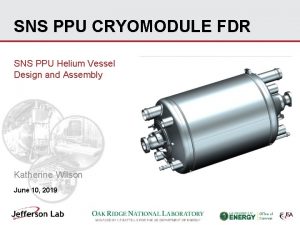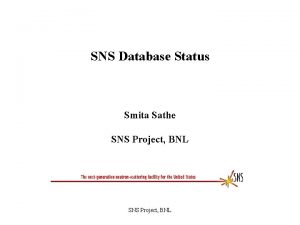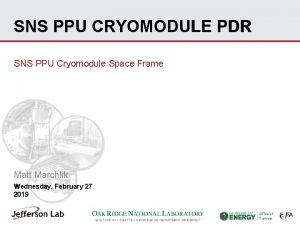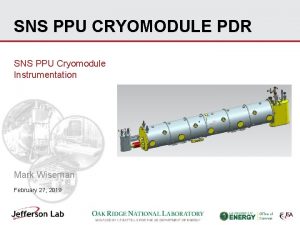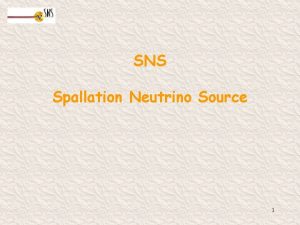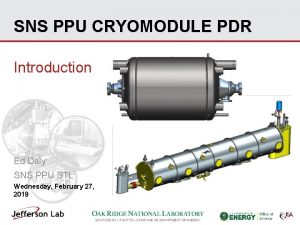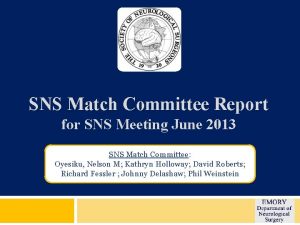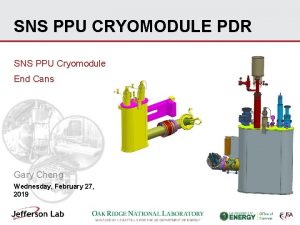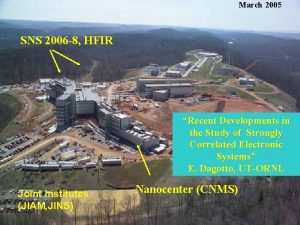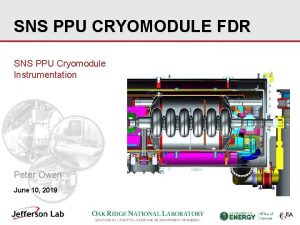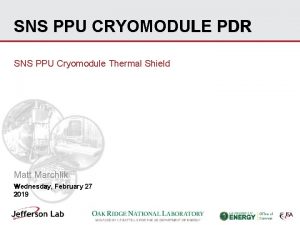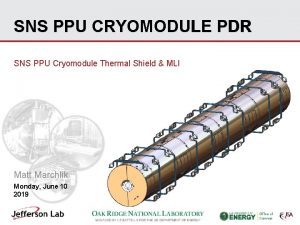Top quark studies at CMS Andrea Giammanco SNS










![Direct |Vtb| extraction s~|Vtb|2 DVtb/Vtb=½Ds/s=½[(S+B)½/S + th. err. ] s-channel: t-channel: 4% 10% renorm. Direct |Vtb| extraction s~|Vtb|2 DVtb/Vtb=½Ds/s=½[(S+B)½/S + th. err. ] s-channel: t-channel: 4% 10% renorm.](https://slidetodoc.com/presentation_image_h/1197419da60089b74634bf816bc573c1/image-11.jpg)



















- Slides: 30

Top quark studies at CMS Andrea Giammanco – SNS & INFN Pisa n n Advantages of LHC QCD production (ttbar pairs) EW production (single top) What can Tevatron do for LHC? 29 April 2005

LHC is a top factory stt(th)=825± 150 pb NNLO-NNNLL: Kidonakis, Vogt, PRD 68 (03) 114014 This means 8 millions tt pairs/year (1 pair/second) at low luminosity! qq->tt: 13% gg->tt: 87%

Advantage of LHC: S/B 1. 96 Te. V 14 Te. V ttbar pairs 6. 70+0. 71 -0. 88 pb 825± 150 pb Single top (s-channel) 0. 75± 0. 12 pb 10± 1 pb Single top (t-channel) 1. 47± 0. 22 pb 245± 17 pb (x 170) Single top (Wt channel) 0. 15± 0. 04 pb 60± 10 pb (x 400) Wjj (*) ~1200 pb ~7500 pb (x 6) bb+other jets (*) ~2. 4 x 105 pb ~5 x 105 pb (x 2) (*) Belyaev, Boos, and Dudko [hep-ph/9806332] (x 120) (x 10)

Top mass Tevatron expectations ( mt 3 Ge. V) LHC expectations ( mt 1 Ge. V) (Note: mostly based on fast simulation studies)

Top mass at CMS Semileptonic channel: CMS note 2001/001 • 0. 2% efficiency • Total background 5% • Mass extracted from jjb system (-> large error from jet scale uncertainty) • Stat. error: ± 0. 25 Ge. V • Error from Pt(t) spectrum: ± 0. 4 Ge. V • Jet scale: DEj/Ej~1% -> DM~± 0. 3 Ge. V mt 1 -2 Ge. V Caveat: this result has been obtained with fast simulation. Full simulation analyses (also with higher degree of sofistication) are under way, also for fully leptonic & fully hadronic channels.

Top mass at CMS: t->J/y CMS note 1999/065 Hard lepton + J/y: 1000 events/year @ L=1034 J/y->mm easy to identify. Ml. J/y has a dependence on Mt. • • Independent from jet scale Unfeasible at low luminosity Promising at high luminosity Among main systematics: b fragmentation mt 1 Ge. V Currently being reproduced with full simulation and J/y->mm + J/y->ee

Spin correlations Since tdecay< thadr, decay products retain “memory” of the top spin (not washed out by hadronization) Discriminates between qq->tt (A = -0. 469) and gg->tt (A = +0. 431 ) MC without spin corr. MC with spin corr. CMS: A/A= 11%(st) 9%(sys) (30 fb-1) ATLAS: A/A= 7%(st) 19%(sys) (30 fb-1) >5 σ from 0 @ 30 fb-1

W polarization in top decay SM predicts the fraction of W from t->W with longitudinal polarization q*: angle between lepton (in W r. f. ) and W (in top r. f. ) Trasv. : (1 cos q*)2 Long. : sin 2 q* tot. long. Acceptance and detector smearing trasv. Þ uncertainty on the fraction of long. pol. W‘s: 0. 023 (stat) 0. 022 (sys)

Single top s-channel =10 pb n n n t-channel =247 pb Wt-channel =56 pb Never observed so far (not a Vtb/SVti ratio -> no assumption Directly related to |Vtb| on the number of quark generations) Sensitivity to new physics: FCNC (t-ch. ), new gauge bosons (s-ch. ), H±->tb … Background to tt and several searches (tt. H, WH->lnbb, …) Possibility to study top properties (mass, polarization, charge) with very little reconstruction ambiguities

Single top: “how to” General strategy (both s/t-ch. ): n 1 isolated lepton n 2 high Et jets nat least 1 tagged b-jet nmissing Et nl+MET: MT compatible with W n. Ht (scalar sum of all Et’s) n. M(lnb) in a window around Mt s/t-channel separation: n 2(b-t-b)/1 tagged b-jets n 0/1 jets in the forward calo n 2/1 central jets nangular distance between the reco top and the remaining jet For MET and Ht, single top lies in the middle between non-top and ttbar bkgs. S -channel: S/B<0. 2, main bkgs: ttbar->2 l (1 lost), Wbb, t-channel. T-channel is much easier to select, due to higher cross section and unique topology. 3 rd jet: b (mostly undetectable) T-channel CMS note 1999/048 2 nd jet: recoil 1 st jet: b from t
![Direct Vtb extraction sVtb2 DVtbVtb½Dss½SB½S th err schannel tchannel 4 10 renorm Direct |Vtb| extraction s~|Vtb|2 DVtb/Vtb=½Ds/s=½[(S+B)½/S + th. err. ] s-channel: t-channel: 4% 10% renorm.](https://slidetodoc.com/presentation_image_h/1197419da60089b74634bf816bc573c1/image-11.jpg)
Direct |Vtb| extraction s~|Vtb|2 DVtb/Vtb=½Ds/s=½[(S+B)½/S + th. err. ] s-channel: t-channel: 4% 10% renorm. scale 4% 5% DMt (± 2 Ge. V) 5% 2% We need to know PDF better the gluon and b PDFs Wt-channel: 50% th. error (range of values in literature) (ATLAS stat. err. : s-ch. 5. 4%, t-ch. 0. 7%, Wt 2. 8%) This makes s-channel preferred

Direct |Vtb| extraction: single top / single W Moreover, in principle, many theoretical errors would disappear by normalising s-channel events over single W events: (*) R(|Vtb|)= m (with care in choosing coherent cuts for the two processes, to avoid the reintroduction of the same errors in a subtler way)

Polarization in t-channel • Standard Model consistency check: single tops have to be polarized • Many new physics scenarios give |g. R|>0 (d. G/G)/d(cos q)=½(1+Acos q) A(l)=+1, A(b)=-0. 40 , A( )=-0. 33 q: lepton/chirality axis angle In the ultrarelativistic limit, chirality~elicity. Not the top case! Mahlon (hep-ph/9811219): in the top r. f. , spin axis is always parallel to the “down” quark direction. In t-channel its better approximation is the recoil jet axis. ATLAS: ± 1. 6% precision on top polarization @10 fb-1

Single top and SUSY bg->t. H± Beccaria, Renard, Verzegnassi (hep-ph/0410089) NLL computation of single top production in a “light” SUSY scenario (350 -400 Ge. V). Main consideration: the only relevant SUSY parameter is tanb Effects: >10% in any channel, in particular in associated production (bg->t. Y, Y=W, H). Strong dependence on tanb. bg->t. W±: • cosq asimmetry • no tanb dependence bg->t. H±: • no cosq asimmetry • tanb dependence

Top charge Atlas Qt = +2/3 Qt = -4/3 • Is the discovered “top quark” a charge 4/3 pseudo-quark? D. Chang, W. F. Chang, E. Ma, Physical Review D 59 091503 • Global EW fit is consistent with this hypothesis, given a “true top” mass ~230 Ge. V • In Run I, CDF and D 0 were not able to distinguish among (W+b)(W-bbar) and (Wb)(W+bbar): angular correlations + jet charge determination is a very difficult task. The two competing hypotheses on |Qt| may be tested from: v QED coupling: rate of ttg and t->b. Wg evts Feasible with v estimation of b-jet charge 10 fb-1

Qt from single top, t-channel v Cross section at LHC is not that small (250 pb, against 825 pb for ttbar) v Very characteristic topology allows selection of high purity samples v Top may be reconstructed with very little ambiguity (usually only 1 b in acceptance) v Determination of b flavour (b/b) is a determination of |Q(t)| (assuming |Q(b)|=1/3) b b ATLAS result: b/b separation already possible after 1 year at LHC

What can Tevatron do for LHC? n n n Very similar environment: ideal to test analysis strategies and understand similar systematics (e. g. Underlying Event) W+jets, in particular Wbb(X), Wcc(X), Wc(X), are significant backgrounds for Top analyses at both accelerators; different MC models give different kinematics => sizeable differences in efficiency estimates. Improvement by tuning generators to Tevatron data? PDFs for LHC are currently extrapolated from a global fit heavily relying on HERA ep data. - data contribute with a richer menu (e. g. But Tevatron pp constraints to gluon PDF), see next slides. Impression from the outside(*): Currently relatively few studies at CDF+D 0 to constrain PDFs. Is it true? (*) I. e. by watching public results: http: //www-cdf. fnal. gov/physics. html http: //www-d 0. fnal. gov/Run 2 Physics/WWW/

Parton Distribution Functions At high energy, a pp scattering is a parton scattering: y = pseudorapidity t LA P Z W DG The low x region, very important for LHC, is very poorly known ev ol u tio n Þ we need pdf(x, Q 2) to know the c. m. energy of the elementary interaction Extrapolation from HERA data

How to probe PDFs at hadron colliders Process: Partons involved: Di-jets Quarks and gluons (b/c/light-)jet + g/Z (b/c/light) quarks and gluons (b/c/light-)jet + W (c/s/light) quarks and gluons Single W‘s and Z‘s Quarks Drell-Yan Quarks q g g q q g/Z/g l q l g Q’ n q Q W q q W Z/g l

(From a talk by Fred Olness, 20 Dec. 2004)

Conclusions n n n LHC will be a top factory This will allow precision measurements in top physics (e. g. DMt~1 Ge. V looks feasible) Measurements will be limited by systematics Analyses under way in CMS for ttbar and single top production (Physics-TDR completed at the end of 2005) Tevatron can be of big help for LHC physics by studying common sources of uncertainty, e. g. models for Underlying Event, W+jets and PDFs

Backup slides

Why do we like Top so much? n n It exists (but is the least known quark) t + W Radiative corrections are proportional to Mt 2 Mt>MW : this means that the W is not virtual b G proportional to GF, not GF 2. Result: tdecay < thadr (tdecay=1/G(~1. 5 Ge. V), thadr~1/LQCD(~0. 2 Ge. V)) n n n So, even “standard” top physics is unusual! For example, decay products retain information about the quark (e. g. polarization) New particles may decay into top Background for a lot of “new physics” Useful for detector calibration W+

Underlying Event The "transverse" region is defined by 60 o<|f|<120 o and |h|<1. The "transverse" region is perpendicular to the plane of the hard 2 -to-2 scattering and is very sensitive to the "underlying event" component of the QCD Monte-Carlo models.

PDF global fit inputs (From a talk by Fred Olness, 20 Dec. 2004)

Spin flow for single top d u b W+ b t n b W+ l+ u t n b W+ l+ s-channel t-channel EW vertex d W+ momentum spin ½ spin 1

Angular distrib. t->W->l b b is relativistic and left-handed. W can be left-handed or longitudinal. In W’s r. f. : final state of +1 elicity from (1, 0) or (1, -1).

Single top at Tevatron Q(lept)×h(light jet) separa t-ch. /s-ch. Ht= Pt(miss) + Pt(l) + SPt(jets) Expected cross sections: • s-channel: s=0. 88± 0. 11 pb • t-channel: s=1. 98± 0. 24 pb M(l b) discrimina top/non top Run II (162 pb-1): § s+t channels: s<13. 7 pb @95% CL § t-channel only: s<8. 5 pb @95% CL

Jet charge method b b b/b separation feasible already after first years at LHC

Top mass at LHC Errors per year, per channel, per experiment: Error: qqbbl (high p. T) bbl l tt qqbbl (+J/ ) statistic 0. 10 0. 25 0. 90? <0. 05 <1. 0 light jet E scale 0. 20 1. 2? - - - b-jet E scale 0. 60 - - ISR/FSR 1. 5? 0. 2? 1. 0 ? 0. 30? B fragm. 0. 25 0. 10 0. 70 - 0. 60 backgrounds 0. 15 0. 10? negl. 0. 20 PDF negl. 4. 0 0. 20 Total <2. 0? <4. 0? <1. 3? Note: systematics are correlated mt < 1 Ge. V looks realistic. Studies by ATLAS
 Andrea giammanco
Andrea giammanco Giuseppe giammanco
Giuseppe giammanco Top quark decay
Top quark decay Sns. gov. pt
Sns. gov. pt Magnetic bearing
Magnetic bearing Quark lepton symmetry
Quark lepton symmetry Physics wordle
Physics wordle Quark names
Quark names Quark gluon
Quark gluon Quark gluon
Quark gluon Quark matter 2022
Quark matter 2022 Dimsi sir
Dimsi sir Psns and sns
Psns and sns Sns
Sns Barbara pasquini
Barbara pasquini Sns statistics
Sns statistics Sns pg
Sns pg Constituent quark model
Constituent quark model Quark parton model
Quark parton model Quark gluon plasma
Quark gluon plasma Gallbladdert
Gallbladdert Sigma quark composition
Sigma quark composition Sns
Sns Seaborn jointplot pearsonr
Seaborn jointplot pearsonr Sns workshop
Sns workshop Cns and sns
Cns and sns Quarks
Quarks Quark astronomy
Quark astronomy Limbic system and trauma
Limbic system and trauma 6 types of quarks
6 types of quarks Sns neurotransmitters
Sns neurotransmitters
